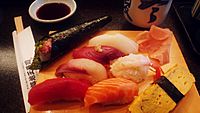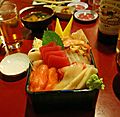Sushi facts for kids

Sushi platter
|
|
| Alternative names | すし, 寿司, 鮨 |
|---|---|
| Course | appetizer, main dish |
| Place of origin | Japan |
| Associated national cuisine | Japanese cuisine |
| Serving temperature | cold |
| Main ingredients | vinegared rice |
| Ingredients generally used | seafood and vegetables |
Sushi (寿司) is a traditional food from Japan. It is a popular dish in other countries as well, such as America, Canada, and the UK, along with many other countries.
Sushi is made with specially prepared rice. The rice is mixed with vinegar, salt, and sugar. Sushi also contains raw or cooked seafood, and sometimes vegetables as well. Sometimes sushi is wrapped in a sheet of seaweed called nori.
There are many different kinds of sushi. The most common sushi in Japan is nigirizushi: fish that is placed on top of a small portion of sushi rice. Sometimes you may find other ingredients on top of rice, such as egg instead of fish. Makizushi consists of rice rolled around fish and/or vegetables. In America, makizushi is more popular than nigirizushi. Another type is known as temaki or a hand roll. This kind of sushi comes in a cone-shape, created by the nori wrapped around the ingredients inside. They are usually filled with a mixture of rice, fish, and vegetables.
Sushi can be eaten with hands or chopsticks. Soy sauce and wasabi are commonly eaten with sushi. Gari (sweet, pickled ginger) can often be found alongside a plate of sushi, used as a palate cleanser.
In Japan, sushi is sometimes sold in "conveyor-belt shops" called kaiten zushi, where plates of sushi are put on a moving belt that passes by the customers. People freely take the sushi they want as it passes. The color of the plate shows the price of the sushi. This way of serving sushi is becoming more popular in other countries as well.
Contents
History
The origin of sushi goes back to Southeast Asia around the 4th century B.C.. In that time, it was called 'narezushi'. Originally the fish was eaten alone, without rice. Then, a style of sushi called 'namanarezushi' reached Japan. 'Namanarezushi' combined the fish with rice.
What we call "sushi" today, was created by Hanaya Yohei (1799–1858) at the end of the Edo period in Edo. Sushi invented by Hanaya was an early form of fast food that was not fermented (therefore prepared quickly) and could be easily eaten with one's hands. Originally, this sushi was known as Edomae zushi because it used freshly caught fish in the Edo-mae (Edo Bay or Tokyo Bay). Though the fish used in modern sushi no longer usually comes from Tokyo Bay, it is still formally known as Edomae nigirizushi.
Health risks
As with most foods, eating sushi has some health risks. However, most can be minimized with proper preparation. Some large fish, such as tuna (especially bluefin), can contain high levels of mercury. Tuna can cause mercury poisoning when consumed in very large quantities over time. Parasite infection by raw fish is not common in the modern world (less than 40 cases per year in the U.S.). Infections can generally be avoided by boiling, burning, preserving in salt or vinegar, or freezing to a certain temperature. Although nigirizushi will almost always appear in a raw form, often much of the fish has been previously frozen to specific temperatures to prevent parasites.
The kinds of the sushi
The kinds of the sushi vary according to each country.
- nigirizushi (Japan)
- makizushi (United states)
- uramakizushi (Europe)
Sushi chain stores in Japan
- Kappa sushi
- Sushiro
- Kurazushi
- Hamazushi
- Choushimaru
- Sushiro
Images for kids
-
Sushi by Hiroshige in Edo period
-
Ehōmaki with a setsubun mask
-
Sea urchin roe "gunkanmaki"
-
Norway roll (ノルウェー巻き). Bjorn Eirik Olsen, a Norwegian businessman, introduced the use of salmon as a sushi ingredient to Japanese in the 1980s.
-
Sushi chef preparing nigirizushi, Kyoto, Japan
-
Sheets of nori.
See also
 In Spanish: Sushi para niños
In Spanish: Sushi para niños





















